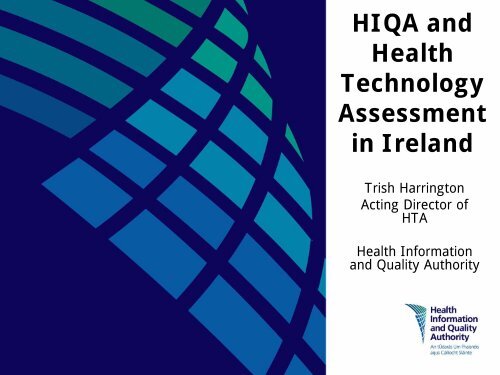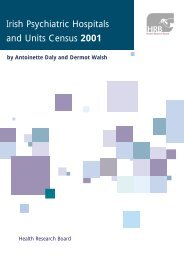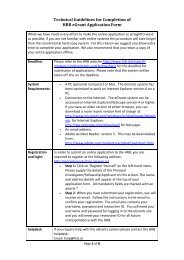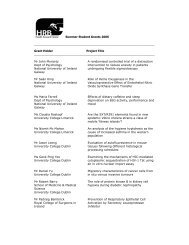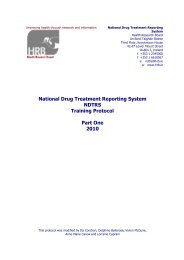HIQA and Health Technology Assessment in Ireland
HIQA and Health Technology Assessment in Ireland
HIQA and Health Technology Assessment in Ireland
You also want an ePaper? Increase the reach of your titles
YUMPU automatically turns print PDFs into web optimized ePapers that Google loves.
<strong>HIQA</strong> <strong>and</strong><br />
<strong>Health</strong><br />
<strong>Technology</strong><br />
<strong>Assessment</strong><br />
<strong>in</strong> Irel<strong>and</strong><br />
Trish Harr<strong>in</strong>gton<br />
Act<strong>in</strong>g Director of<br />
HTA<br />
<strong>Health</strong> Information<br />
<strong>and</strong> Quality Authority
<strong>HIQA</strong> Organisational<br />
Structure<br />
Board of the<br />
Authority<br />
Corporate Services<br />
Chief Executive<br />
Communications &<br />
Stakeholder Engagement<br />
<strong>Health</strong>care Quality<br />
<strong>and</strong> Safety<br />
Social Services<br />
Inspectorate<br />
<strong>Health</strong> <strong>Technology</strong><br />
<strong>Assessment</strong><br />
<strong>Health</strong> Information
<strong>Health</strong>care Quality <strong>and</strong> Safety<br />
Framework for cont<strong>in</strong>uous quality improvement -<br />
st<strong>and</strong>ards for cl<strong>in</strong>ical <strong>and</strong> corporate governance<br />
Assure the m<strong>in</strong>imum quality of service,<br />
m<strong>and</strong>atory reviews of organisations<br />
Provide programme of ‘accreditation’ to enable<br />
demonstrable move towards excellence<br />
Undertake condition/service-specific system<br />
reviews<br />
Investigate serious concerns
Social Services Inspectorate<br />
Monitor, register <strong>and</strong> <strong>in</strong>spect residential services<br />
for:<br />
• Dependent older people<br />
• People with disabilities<br />
• Children <strong>in</strong> need of care <strong>and</strong> protection<br />
• Sett<strong>in</strong>g st<strong>and</strong>ards for assessment of need under<br />
the Education for Persons with Special<br />
Educational Needs (EPSEN) <strong>and</strong> Disability Acts
<strong>Health</strong> Information<br />
Identify<strong>in</strong>g <strong>and</strong> advis<strong>in</strong>g on health <strong>in</strong>formation<br />
deficiencies<br />
Sett<strong>in</strong>g st<strong>and</strong>ards for health <strong>in</strong>formation<br />
systems<br />
Establish<strong>in</strong>g an <strong>in</strong>formation governance<br />
framework<br />
Evaluat<strong>in</strong>g <strong>and</strong> provid<strong>in</strong>g accurate health<br />
<strong>in</strong>formation<br />
Establish<strong>in</strong>g an e<strong>Health</strong> <strong>in</strong>formation portal for<br />
the public
<strong>Health</strong><br />
<strong>Technology</strong><br />
<strong>Assessment</strong>
Perceptions<br />
Sunday<br />
Bus<strong>in</strong>ess<br />
Post<br />
February<br />
2007
HSE cutbacks triggered by €350m shortfall
<strong>Health</strong> <strong>Technology</strong><br />
<strong>Assessment</strong><br />
Objective:<br />
To <strong>in</strong>form safe <strong>and</strong> effective health policies<br />
that are patient focussed <strong>and</strong> achieve best<br />
value
Why carry out HTA?<br />
• Introduce technologies speedily with<br />
proven, significant health benefits,<br />
• Prevent the <strong>in</strong>troduction of technologies<br />
which fail to meet the requirements of<br />
evidence-based analysis, <strong>and</strong><br />
• Cont<strong>in</strong>uously monitor the effectiveness of<br />
technologies after their <strong>in</strong>troduction.<br />
Quality & Fairness<br />
National <strong>Health</strong> Strategy 2001
<strong>Health</strong> Act 2007<br />
The functions of the Authority are as follows….<br />
To evaluate the cl<strong>in</strong>ical <strong>and</strong> cost-effectiveness<br />
of health technologies <strong>in</strong>clud<strong>in</strong>g drugs <strong>and</strong><br />
provide advice aris<strong>in</strong>g out of the evaluation to<br />
the M<strong>in</strong>ister <strong>and</strong> the Executive
HTA<br />
• HTA is a multidiscipl<strong>in</strong>ary process that<br />
summarises <strong>in</strong>formation about:<br />
– Medical<br />
– Social<br />
– Economic (VFM)<br />
– Organisational<br />
– Ethical<br />
– Medicolegal issues<br />
related to the diffusion <strong>and</strong> use of a health<br />
technology <strong>in</strong> a systematic, transparent,<br />
unbiased <strong>and</strong> robust manner
<strong>Health</strong> Technologies<br />
• Includes a wide range of <strong>in</strong>terventions used <strong>in</strong><br />
healthcare <strong>and</strong> health promotion<br />
– Pharmaceuticals (Drugs)<br />
– Medical Devices<br />
– Diagnostics<br />
– Medical <strong>and</strong> surgical procedures<br />
– Public health activities<br />
• Includes the systems with<strong>in</strong> which health is<br />
protected <strong>and</strong> ma<strong>in</strong>ta<strong>in</strong>ed
HTA Directorate Objectives<br />
• Establish a Quality Framework for HTA<br />
• Promote conduct of high quality HTAs<br />
• Independent conduct of HTAs with national<br />
significance<br />
• Develop HTA capacity
Quality Framework<br />
Programme Advisory Group<br />
Scientific Advisory Group<br />
H<br />
I<br />
Q<br />
A<br />
HTA Expert<br />
Advisory<br />
Group<br />
HTA Expert<br />
Advisory<br />
Group<br />
DoHC<br />
HSE<br />
HTA<br />
Evaluation<br />
Team<br />
HTA<br />
Evaluation<br />
Team
Quality Framework<br />
Opportunities<br />
• Stakeholder Engagement<br />
• National guidel<strong>in</strong>es<br />
• Best practice from other jurisdictions<br />
– International networks<br />
– Strategic Partnerships<br />
– Collaborative Approach (Horizon Scann<strong>in</strong>g, Core<br />
HTAs, Research)
Quality Framework<br />
Stakeholder engagement<br />
• Patients/Service Users<br />
– Programme Ad Group, Scientific Ad Group, Expert Ad Groups<br />
– Focus Groups<br />
• Decision Makers<br />
– Programme Ad Group, Scientific Ad Group, Expert Ad Groups<br />
– Key to successful implementation<br />
• Industry<br />
– Programme Ad Group, Scientific Ad Group<br />
– IPHA Agreement<br />
• Academics/Cl<strong>in</strong>icians<br />
– Programme Ad Group, Scientific Ad Group, Expert Ad Groups<br />
– Evaluation Teams<br />
– Foster HTA expertise <strong>and</strong> quality practice
Quality Framework<br />
National Guidel<strong>in</strong>es<br />
• Guidel<strong>in</strong>es for the Economic Evaluation of <strong>Health</strong><br />
Technologies<br />
– Work with Scientific Advisory Group<br />
– Planned broader consultation process<br />
– Guidel<strong>in</strong>es <strong>in</strong>creas<strong>in</strong>g prescriptive – establish ‘Reference Case’ or preferred set of<br />
st<strong>and</strong>ards for use <strong>in</strong> the ‘Base Case’ analysis<br />
– Focus on the publicly funded healthcare system <strong>in</strong> Reference Case<br />
– Reflect <strong>in</strong>ternational trends <strong>in</strong> economic analysis<br />
• Planned additional sections<br />
– Procedures <strong>and</strong> processes of the Authority for the identification, prioritisation <strong>and</strong><br />
selection of topics for assessment<br />
– Sections on the social, ethical <strong>and</strong> organisational aspects of HTA<br />
– Budget impact analysis<br />
– Recommended report<strong>in</strong>g formats
HTA Directorate Objectives<br />
• Establish a Quality Framework for HTA<br />
• Promote conduct of high quality HTAs<br />
• Independent conduct of HTAs with national<br />
significance<br />
• Develop HTA capacity
Promote Conduct of Quality HTA<br />
Types of HTA conducted <strong>in</strong> Irel<strong>and</strong>:<br />
• HTAs of national significance by <strong>HIQA</strong><br />
– use of <strong>in</strong>dependent economic models<br />
• ‘Rapid HTA’: under HSE/IPHA agreement<br />
– new pharmaceuticals on Community Drugs Schemes<br />
– review of company submissions<br />
• ‘M<strong>in</strong>i-HTA’: to <strong>in</strong>form local level decision-mak<strong>in</strong>g<br />
– technologies <strong>in</strong>clud<strong>in</strong>g drugs at local hospital level<br />
– non-pharmaceuticals through PCCC, e.g., CF Physiotherapy Vest
HTA Directorate Objectives<br />
• Establish a Quality Framework for HTA<br />
• Promote conduct of high quality HTAs<br />
• Independent conduct of HTAs with<br />
national significance<br />
• Develop HTA capacity
<strong>HIQA</strong> HTA Process: Prioritisation<br />
• Priority Diseases<br />
• High budget<br />
• Safety concerns<br />
• Organisational issues<br />
• Horizon Scann<strong>in</strong>g<br />
• National impact (public <strong>and</strong> private)
HTA Directorate Objectives<br />
• Establish a Quality Framework for HTA<br />
• Promote conduct of high quality HTAs<br />
• Independent conduct of HTAs with<br />
national significance<br />
• Develop HTA capacity
Develop HTA Capacity<br />
• HTA Capacity Build<strong>in</strong>g<br />
– Synergistic relationships<br />
– Adequate remuneration, Multi-annual fund<strong>in</strong>g<br />
– Post-graduate fellowships<br />
– NCI / HRB PhD programme<br />
– Ad hoc tra<strong>in</strong><strong>in</strong>g<br />
– HTA Forum
HTA: Challenges<br />
• Quality of HTAs<br />
– Different levels of expertise, experience <strong>and</strong><br />
skills<br />
• HTA Capacity Build<strong>in</strong>g<br />
• Communications<br />
• Implementation
Implementation of HTA:<br />
Enhanc<strong>in</strong>g Factors<br />
• Prioritisation by decision makers<br />
• Culture of HTA<br />
• Scientific reputation <strong>and</strong> credibility of HTA<br />
agency<br />
• High quality HTA<br />
• Compact user-friendly presentation<br />
• Pharmaceuticals versus other technologies
Implementation of HTA:<br />
H<strong>in</strong>der<strong>in</strong>g Factors<br />
• Strong <strong>in</strong>fluence of stakeholders<br />
• Long st<strong>and</strong><strong>in</strong>g beliefs<br />
• Recommendations differ from experience of<br />
cl<strong>in</strong>icians<br />
• <strong>Technology</strong> <strong>in</strong>troduced pre-HTA
Issues for Conduct of HTA<br />
• Skill sets:<br />
– Cl<strong>in</strong>ical evaluation, systematic review,<br />
biostatistics, mathematical programm<strong>in</strong>g,<br />
health economics, health services research,<br />
ethical <strong>and</strong> legal expertise<br />
• Cost data<br />
• HTA guidel<strong>in</strong>es
1 st HTA Undertaken<br />
Objective:<br />
To estimate the costeffectiveness<br />
of a comb<strong>in</strong>ed<br />
national HPV vacc<strong>in</strong>ation<br />
<strong>and</strong> cervical screen<strong>in</strong>g<br />
programme compared to a<br />
screen<strong>in</strong>g programme alone<br />
<strong>in</strong> the prevention of cervical<br />
dysplasia <strong>and</strong> cervical<br />
cancer due to HPV types 16<br />
<strong>and</strong> 18 <strong>in</strong> Irel<strong>and</strong>
Human Papillomavirus (HPV)<br />
• More than 100 different types of HPV <strong>in</strong>fection have<br />
been characterised:<br />
– High risk – most common are HPV 16, 18, 45 <strong>and</strong> 31.<br />
– Low risk- <strong>in</strong>clude HPV types 6, 11.<br />
Cause ~ 90%<br />
of anogenital<br />
warts<br />
Cause ~70% of<br />
cervical cancers
Human Papillomavirus (HPV)<br />
Vacc<strong>in</strong>e<br />
• Two vacc<strong>in</strong>es currently developed:<br />
1. Gardasil ® – protects aga<strong>in</strong>st HPV types 16, 18, 6 <strong>and</strong> 11.<br />
2. Cervarix ® – protects aga<strong>in</strong>st HPV types 16 <strong>and</strong> 18.<br />
• Efficacy demonstrated for up to 5.5 years after<br />
vacc<strong>in</strong>ation.<br />
• Requirement for booster dose at later time not<br />
established.<br />
• Rout<strong>in</strong>e cytology screen<strong>in</strong>g still required, as vacc<strong>in</strong>es do<br />
not protect aga<strong>in</strong>st all oncogenic types of HPV.
Methods<br />
• Adaptation of an <strong>in</strong>dependently developed dynamic<br />
model<br />
• Herd immunity is reflected <strong>in</strong> the model<br />
• HPV type 16 <strong>and</strong> 18 <strong>in</strong>fection only<br />
• Outcome measure: Life Years Ga<strong>in</strong>ed<br />
• Comparator: Population-based cervical cancer screen<strong>in</strong>g<br />
programme<br />
• Perspective: <strong>Health</strong>care payer i.e., HSE
Data Inputs<br />
• Duration of protection: lifelong<br />
• Vacc<strong>in</strong>e efficacy: 95% <strong>in</strong> HPV-naïve ITT population<br />
0% <strong>in</strong> HPV-exposed <strong>in</strong>dividuals<br />
• Delivery of the vacc<strong>in</strong>ation programme:<br />
– School-based programme (12-19 year olds )<br />
– GP adm<strong>in</strong>istration (19 - 26 year olds)
Vacc<strong>in</strong>ation Scenarios<br />
Scenarios<br />
Vacc<strong>in</strong>e<br />
coverage<br />
1. Annual vacc<strong>in</strong>ation of 12-year old girls 80%<br />
2. Annual vacc<strong>in</strong>ation of 12-year old girls with catchup<br />
to 15 years <strong>in</strong> 1 st vacc<strong>in</strong>ation year<br />
3. Annual vacc<strong>in</strong>ation of 12-year old girls with catchup<br />
to 17 years <strong>in</strong> 1 st vacc<strong>in</strong>ation year<br />
4. Annual vacc<strong>in</strong>ation of 12-year old girls with catchup<br />
to 19 years <strong>in</strong> 1 st vacc<strong>in</strong>ation year<br />
5. Annual vacc<strong>in</strong>ation of 12-year old girls with catchup<br />
to 26 years <strong>in</strong> 1 st vacc<strong>in</strong>ation year<br />
80%<br />
80%<br />
80%<br />
80% (school)<br />
30% (GP)
Cost of Vacc<strong>in</strong>ation<br />
• Ex factory price per dose:<br />
€100 (€80-€120)<br />
• Cost of adm<strong>in</strong>istration:<br />
– School based programme cost per dose:<br />
€30 (€15-€45)<br />
– GP adm<strong>in</strong>istration fee: cost per dose:<br />
€58 (€50-€67)<br />
• Sensitivity analysis:<br />
One booster dose after 10 years
Results<br />
Compared to a screen<strong>in</strong>g programme alone,<br />
comb<strong>in</strong>ed vacc<strong>in</strong>ation plus screen<strong>in</strong>g:<br />
ICER:<br />
Cost:<br />
12-year-old girls<br />
€17,383 / LYG<br />
€9.7 million per annum<br />
Catch-up: 13-15-year-old girls (one-off)<br />
Marg<strong>in</strong>ally cost-effective<br />
Cost €29.2 million
<strong>Health</strong> Technologies<br />
Colorectal Cancer Screen<strong>in</strong>g<br />
• To evaluate the cl<strong>in</strong>ical <strong>and</strong> costeffectiveness,<br />
resource implications <strong>and</strong><br />
ethical considerations of a population-based<br />
colorectal cancer screen<strong>in</strong>g programme
Vision<br />
HTA programme which contributes substantially<br />
to improv<strong>in</strong>g patient outcomes by support<strong>in</strong>g<br />
<strong>in</strong>vestment <strong>in</strong> effective, efficient technologies<br />
Quality Framework<br />
Stakeholder engagement:<br />
- National Guidel<strong>in</strong>es - Patients / Service users<br />
- International peer review - Decision Makers<br />
- Service Providers<br />
- <strong>Technology</strong> Industry<br />
- Academic Groups
Thank You


